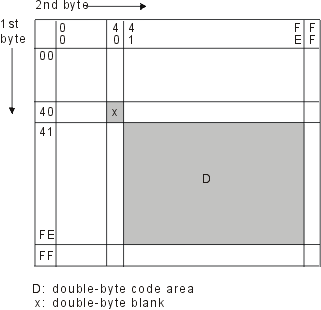IBM® supports two DBCS code schemes: one for the host servers, the other for personal computers.
- First byte
- hex 41 to hex FE
- Second byte
- hex 41 to hex FE
- Double-byte blank
- hex 4040
In Figure 1, using the first byte as the vertical axis and the second byte as the horizontal axis, 256 x 256 intersections or code points are expressed. The lower-right code area is designated as the valid double-byte code area and x is assigned to the double-byte blank.
By assigning the values hex 41 to hex FE in the first and second bytes as the DBCS codes, the codes can be grouped in wards with 192 code points in each ward. For example, the code group with the first byte starting with hex 42 is called ward 42. Ward 42 has the same alphanumeric characters as those in a corresponding single-byte EBCDIC code page, but with double-byte codes. For example, the character A is represented in single-byte EBCDIC code as hex C1 and in IBM-host code as hex 42C1.
- IBM Japanese character set
- IBM Korean character set
- IBM Simplified Chinese character set
- IBM Traditional Chinese character set
| Wards | Content | Number of Characters |
|---|---|---|
| 40 | Space in 4040 | 1 |
| 41 to 44 | Non-Kanji characters
|
549 |
| 45 to 55 | Basic Kanji characters | 3226 |
| 56 to 68 | Extended Kanji characters | 3487 |
| 69 to 7F | User-defined characters | Up to 4370 |
| 80 to FE | Reserved | |
| Total number of IBM-defined characters: 7263 |
||
| Wards | Content | Number of Characters |
|---|---|---|
| 40 | Space in 4040 | 1 |
| 41 to 46 | Non-Hangeul/Hanja characters (Latin alphabet, Greek, Roman, Japanese Kana, numeric, special symbols) | 939 |
| 47 to 4F | Reserved | |
| 50 to 6C | Hanja characters | 5265 |
| 6D to 83 | Reserved | |
| 84 to D3 | Hangeul characters (Jamo included) | 2672 |
| D4 to DD | User-defined characters | Up to 1880 |
| DE to FE | Reserved | |
| Total number of IBM-defined characters: 8877 |
||
| Wards | Content | Number of Characters |
|---|---|---|
| 40 | Space in 4040 | 1 |
| 41 to 47 | Non-Chinese characters (Latin alphabet, Greek, Russian, Japanese Kana, numeric, special symbols) | 712 |
| 48 to 6F | Chinese characters: Level 1 and Level 2 | 3755 and 3008 |
| 70 to 75 | Reserved | |
| 76 to 7F | User-defined characters | Up to 1880 |
| 80 to FE | Reserved | |
| Total number of IBM-defined characters: 7476 |
||
| Wards | Content | Number of Characters |
|---|---|---|
| 40 | Space in 4040 | 1 |
| 41 to 49 | Non-Chinese characters (Latin alphabet, Greek, Roman, Japanese Kana, numeric, special symbols) | 1003 |
| 4A to 4B | Reserved | |
| 4C to 68 | Primary Chinese characters | 5402 |
| 69 to 91 | Secondary Chinese characters | 7654 |
| 92 to C1 | Reserved | |
| C2 to E2 | User-defined characters | Up to 6204 |
| E3 to FE | Reserved | |
| Total number of IBM-defined characters: 14060 |
||
This code scheme applies to the iSeries server, System/36™, System/38™, as well as the System/370™ server. A different DBCS code scheme, called the IBM Personal Computer DBCS code scheme, is used on the Personal System/55. For details of the IBM Personal Computer DBCS code scheme, refer to IBM PS/55 publications.
